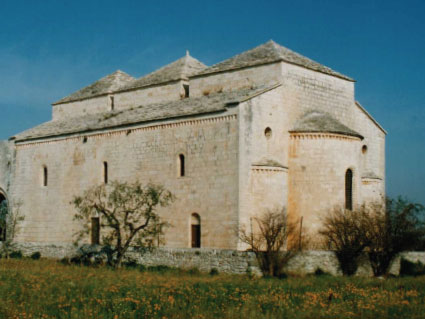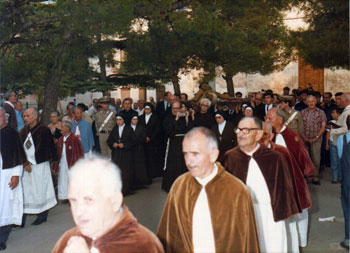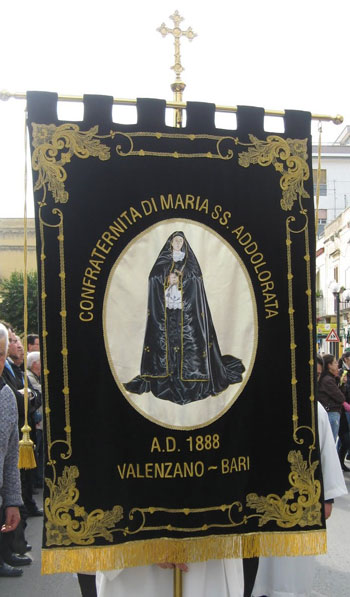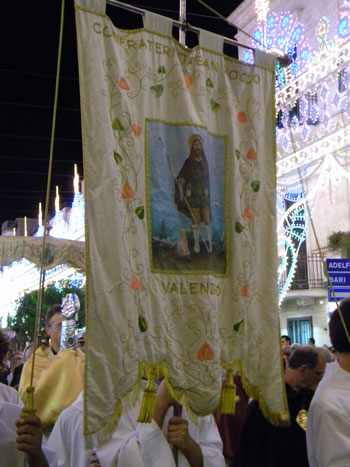





In relation to place of residence, professional activities, and ecclesiastical connections, the Confraternities are distinguishable for their special devotion to a particular saint or cult that inspires them, incites their trust, and therefore whose name they adopt. They have their own churches, chapels, altars, dedicated to their worship, and sometimes these are embellished with splendid works of art, distinctive robes, insignia, sacred objects, and even their own prayers, and even literary and musical texts. Valenzano does not appear to intend to move away from these practises. There are eight confraternities in its religious history. The oldest of the confraternities is that of the Holy Body of Christ, or the Holy sacrament (SS. Sacramento) founded soon after the Council of Trento (1563), followed by the confraternity of Our Lady of the Most Holy Rosary (Maria SS. del Rosario) in 1578, that of Purgatory (Purgatorio) in about 1665, and at the start of the 18th century those of St.. Rocco, and of the Immaculate Conception (dell’Immacolata Concezione), the Confraternity of Our Lady of Sorrows (dell’Addolorata)in 1888, and in 1908 the confraternities of the Scapular (Scapolare) or Our Lady of Mount Carmel (Madonna del Carmine ) and of St. Anthony. At the end of the 20th century only a small group of sisters of Our Lady of Sorrows remained. With the start of the third millennium the ancient traditions were infused with new energy by the Confraternities of St. Rocco, and Our Lady of Sorrows.

The closure of the monastery of Benedictine Cistercian Madonna of Loreto monastery in 1866, led after two years to the constitution of the Pious Union of Brothers and Sisters under the title of the Confraternity of Holy Mary Our Lady of Sorrows, based in the same ex-monastery conceded by the local authorities under certain conditions, following duly approved deliberation on 17th January, 20th April, and 30th June 1895. In 1897 the Confraternity had fifty-eight brothers and seventy sisters. It took care of the church of S. Maria di Loreto, of the cults worshipped there and the rites connected with Holy Week. The festivities of Our Lady of Sorrows were celebrated in September and November in honour of the confraternity's Protector, Holy Mary Our Lady of Sorrows, with religious functions, solemn Masses, and processions through he town accompanied by a marching band. Starting from the 1960s the number of members of the Confraternity gradually diminished. However, over recent years it appears that belief has been infused with renewed life, and is once again chiefly bound to the rites of Holy Week.

The cult of St. Rocco has been present in Valenzano since 1543, when a chapel dedicated to him was built by the new defensive wall near Porta Nuova along the road to Bari. During the plague epidemic of 1656 Valenzano officially gave thanks to St. Rocco for having escaped the danger of the worst episode of plague this province had ever seen. Faith in this saint was so strong that at the beginning of the 1700s the Confraternity of St. Rocco was founded, and approved by Royal decree in 1780. Probably in the same period, with the involvement of the Confraternity and a few local historical figures, a precious relic of the Saint, a bone from his forearm, was brought to Valenzano, and placed in a silver arm and solemnly displayed for veneration on feast days. For the extremely imposing celebrations the entire church is adorned with drapes and the town decorated with lights and ornaments on the houses and in the streets; there are three processions with numerous participants, pilgrims, brothers of the Confraternity and people representing important figures on horseback. The feast day of St. Rocco, even amidst the devout fervour of the common religiousness, was, during the years of the reconstruction (the post-war period, and for many immigrants a destination for summer vacations in their land of origin, and for many have-nots in the area an accessible mid-August holiday, with music and good food. Today with the change in economic and social conditions, the idea is to rediscover the religious, historical, and anthropological values of the feast day celebrations. The Confraternity appears to be benefiting from this too, the number of its members is growing once more, as is the participation in religious rites and the connected traditions.